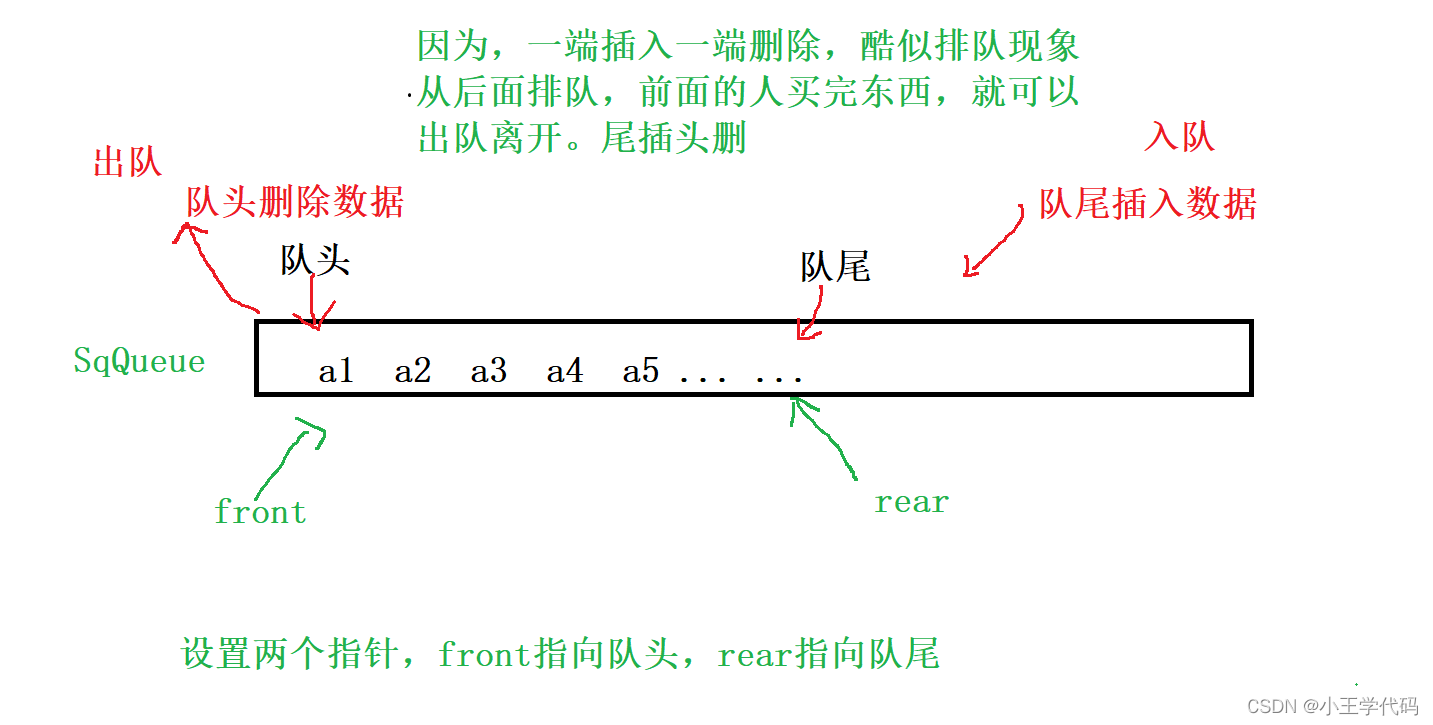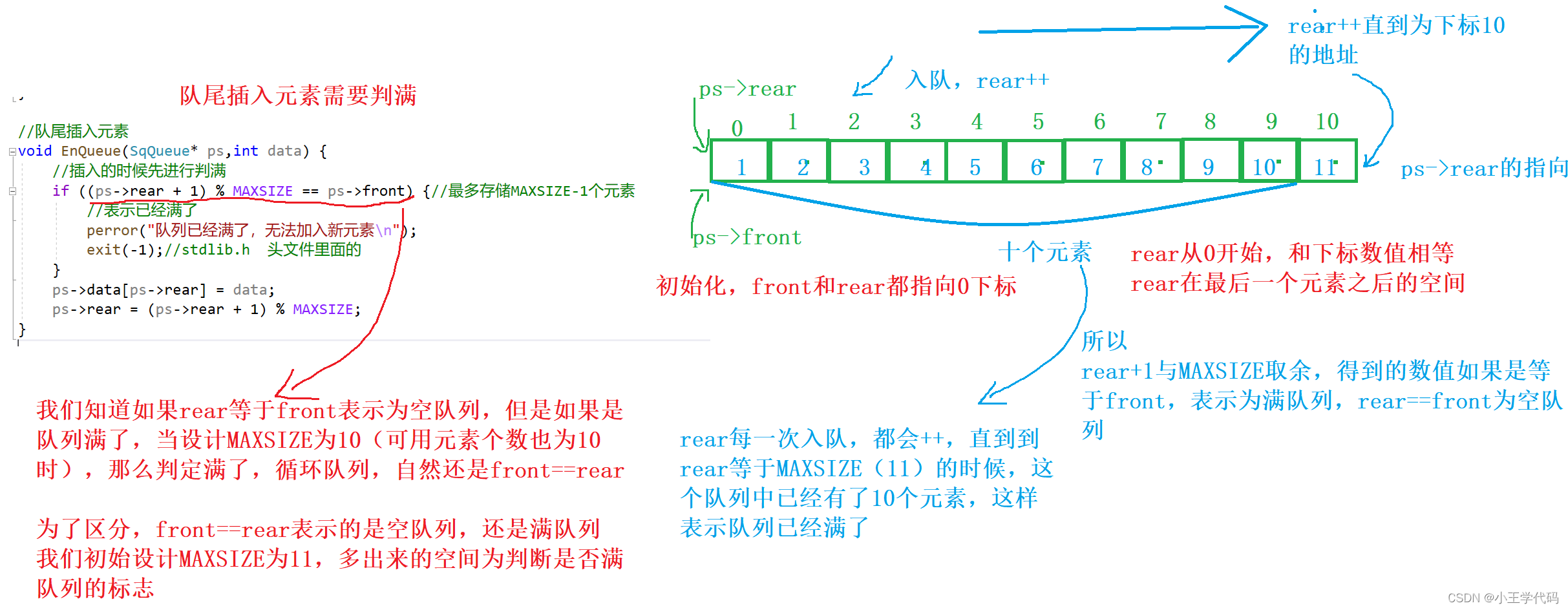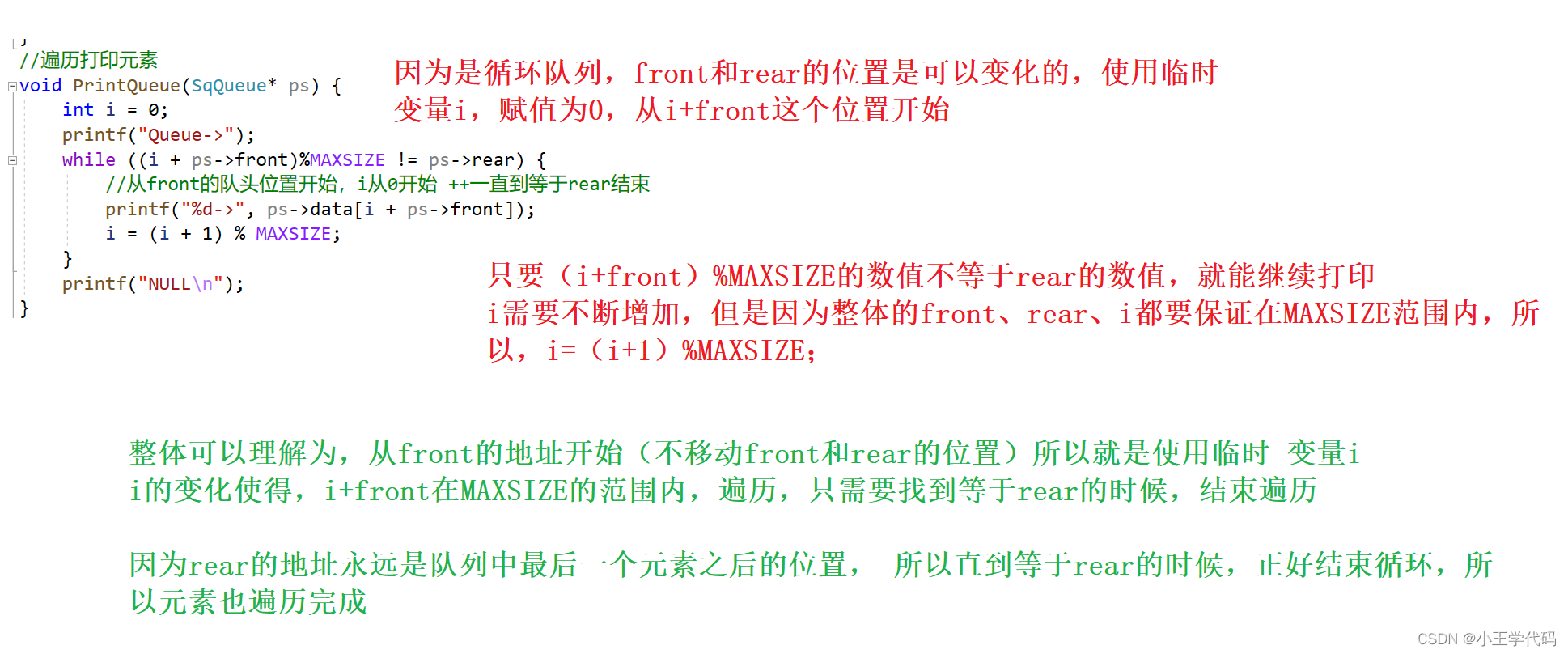- 1git commit报错subject may not be empty_subject may not be empty [subject-empty]
- 2解决项目提示 Cannot change version of project facet Dynamic Web Module to 2.5 错误
- 3Hadoop集群 手动主备切换 (Active - Standby)_hadoop主节点由standby边为active的命令
- 4FPGA IO命名与Bank划分_如何判断a7的fpga io是不是hp bank
- 5KNN算法_knn算法k值的选择
- 6轻松上手MYSQL:MYSQL初识(上)
- 7探索 JustTrustMe:一款提升软件安全性的利器
- 8干货下载 | 数据管理国家标准DCMM、金融数据中台建设方法论,限时领取_金融行业数据中心基础设施等级认证技术规范
- 9Linux 基础知识:指令与shell_linux的ls命令来自内核还是shell
- 10Stable Diffusion超详细教程!从0-1入门到进阶_开源 sd 本地
【数据结构和算法】认识队列,并实现循环队列_1)设计和实现一个队列数据结构,且采用循环队列实现,采用少用一个元素的方式进行存
赞
踩
上接前文,我们学习了栈的相关知识内容,接下来,来认识一个与栈类似的,另一种特殊的线性表,队列,本文目的是了解并认识队列这一概念,并实现循环队列
目录
一、认识队列
1.队列的概念
队列:只允许在一端进行插入数据操作,在另一端进行删除数据操作的特殊的线性表,队列具有先进先出的特性,在队尾插入数据,称为入队,在队头删除数据,称为出队。
如图所示:
2.队列的实现
队列可以由两种方式来实现,分别可以由顺序表,和链表来实现,队列又分为循环队列,非循环队列。
区分:
1.非循环队列时,使用链表的结构实现更优一些,因为如果使用数组的结构,出队列在数组头上出数据,效率会低一点。
2.循环队列的时候,使用数组更加方便简洁,唯一缺点就是循环队列用数组的时候,只能是静态的数组,动态不能构成循环队列,当然可以使用循环链表
二、实现循环队列
我们使用数组的结构来实现循环队列
1.结构体格式以及初始化
代码如下:
- #define MAXSIZE 11//表示的是数组的元素个数,多一个1,是为了留给rear空间的
- typedef struct SqQueue {
- int data[MAXSIZE];
- int front;//队头
- int rear;//队尾 front 和 rear 就是指针(类似)
- }SqQueue;
-
- //初始化队列
- void InitQueue(SqQueue* ps) {
- //初始化队列只需要队头队尾都为0 表示下标起始位置
- ps->front = ps->rear = 0;
- }
实际上,我们使用的是静态数组,也只有这样我们才能实现循环队列,如果是动态数组,就无法实现循环效果,而且定义的MAXSIZE大小为11,有一个空间是不被存放数值的,作为一个标志。
2.队尾插入元素(入队)
最重要的一点是理解
(rear+1)%MAXSIZE==front 这是判断队列是否为满队列的标志
如图所示:

代码如下:
- //队尾插入元素
- void EnQueue(SqQueue* ps,int data) {
- //插入的时候先进行判满
- if ((ps->rear + 1) % MAXSIZE == ps->front) {//最多存储MAXSIZE-1个元素
- //表示已经满了
- perror("队列已经满了,无法加入新元素\n");
- exit(-1);//stdlib.h 头文件里面的
- }
- ps->data[ps->rear] = data;
- ps->rear = (ps->rear + 1) % MAXSIZE;
- }
3.队头删除数据(出队)
如图所示:

代码如下:
- //队头出队
- //只需要移动指针位置即可
- void OutQueue(SqQueue* ps, int* data) {
- //出队先判别是否为空
- if (ps->rear == ps->front) {
- perror("为空队列,无法出队\n");
- exit(-1);
- }
- *data = ps->data[ps->front];
- ps->front = (ps->front + 1) % MAXSIZE;
- //不需要整体移动只要将队头指针后移就可以
- }
4.打印
如图所示:

代码如下:
- //遍历打印元素
- void PrintQueue(SqQueue* ps) {
- int i = 0;
- printf("Queue->");
- while ((i + ps->front)%MAXSIZE != ps->rear) {
- //从front的队头位置开始,i从0开始 ++一直到等于rear结束
- printf("%d->", ps->data[i + ps->front]);
- i = (i + 1) % MAXSIZE;
- }
- printf("NULL\n");
- }
5.清空队列、返回队头元素、返回队列元素个数
代码如下:
- //将队列清空
-
- void ClearQueue(SqQueue* ps) {
- ps->front = ps->rear = 0;
- }
-
- //返回队头元素
- void GetHead(SqQueue* ps, int* data) {
- if (ps->front == ps->rear) {
- perror("为空队列\n");
- exit(-1);
- }
- *data = ps->data[ps->front];
- }
-
- //返回队列中的元素个数
-
- int CountSqQueue(SqQueue* ps) {
- return (ps->rear - ps->front + MAXSIZE) % MAXSIZE;
- }

三、完整代码实现
- #define _CRT_SECURE_NO_WARNINGS
- #include<stdio.h>
- #include<malloc.h>
- #include<assert.h>
- #include<stdlib.h>
- //构建的是循环队列,是使用数组的形式,完成的循环队列
-
- #define MAXSIZE 11//表示的是数组的元素个数,多一个1,是为了留给rear空间的
- typedef struct SqQueue {
- int data[MAXSIZE];
- int front;//队头
- int rear;//队尾 front 和 rear 就是指针(类似)
- }SqQueue;
-
- //初始化队列
- void InitQueue(SqQueue* ps) {
- //初始化队列只需要队头队尾都为0 表示下标起始位置
- ps->front = ps->rear = 0;
- }
-
- //将队列清空
-
- void ClearQueue(SqQueue* ps) {
- ps->front = ps->rear = 0;
- }
-
- //队尾插入元素
- void EnQueue(SqQueue* ps,int data) {
- //插入的时候先进行判满
- if ((ps->rear + 1) % MAXSIZE == ps->front) {//最多存储MAXSIZE-1个元素
- //表示已经满了
- perror("队列已经满了,无法加入新元素\n");
- exit(-1);//stdlib.h 头文件里面的
- }
- ps->data[ps->rear] = data;
- ps->rear = (ps->rear + 1) % MAXSIZE;
- }
-
- //队头出队
- //只需要移动指针位置即可
- void OutQueue(SqQueue* ps, int* data) {
- //出队先判别是否为空
- if (ps->rear == ps->front) {
- perror("为空队列,无法出队\n");
- exit(-1);
- }
- *data = ps->data[ps->front];
- ps->front = (ps->front + 1) % MAXSIZE;
- //不需要整体移动只要将队头指针后移就可以
- }
- //遍历打印元素
- void PrintQueue(SqQueue* ps) {
- int i = 0;
- printf("Queue->");
- while ((i + ps->front)%MAXSIZE != ps->rear) {
- //从front的队头位置开始,i从0开始 ++一直到等于rear结束
- printf("%d->", ps->data[i + ps->front]);
- i = (i + 1) % MAXSIZE;
- }
- printf("NULL\n");
- }
- //返回队头元素
- void GetHead(SqQueue* ps, int* data) {
- if (ps->front == ps->rear) {
- perror("为空队列\n");
- exit(-1);
- }
- *data = ps->data[ps->front];
- }
-
- //返回队列中的元素个数
-
- int CountSqQueue(SqQueue* ps) {
- return (ps->rear - ps->front + MAXSIZE) % MAXSIZE;
- }
-
- int main() {
- SqQueue Q;
- InitQueue(&Q);
- EnQueue(&Q, 1);
- EnQueue(&Q, 2);
- EnQueue(&Q, 3);
- EnQueue(&Q, 4);
- EnQueue(&Q, 5);
- PrintQueue(&Q);
- int a = 0;
- OutQueue(&Q, &a);
- PrintQueue(&Q);
- EnQueue(&Q, 1);
- EnQueue(&Q, 2);
- //EnQueue(&Q, 3);
- EnQueue(&Q, 4);
- EnQueue(&Q, 4);
- EnQueue(&Q, 5);
- EnQueue(&Q, 5);
- PrintQueue(&Q);
- }
-

总结
本文了解认识队列这一新的概念,我们也通过数组的结构实现循环队列,这一种方式实现循环队列是比较简单好理解的,主要的是理解MAXSIZE为什么要多一个空间,例如设置为11,还有判空,判满,操作。这是最为重要的。
判空:rear==front
判满:(rear+1)%MAXSIZE==front
得到队列元素个数:(rear-front+MAXSIZE)%MAXSIZE
front、rear、i得到下一个位置的方法:
例如:rear=(rear+1)%MAXSIZE


